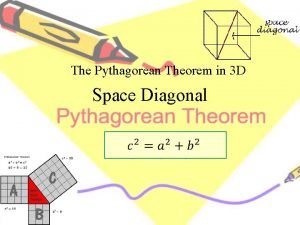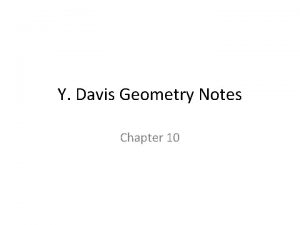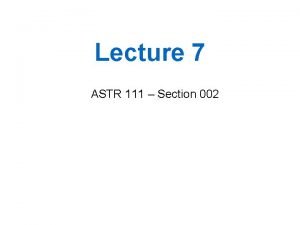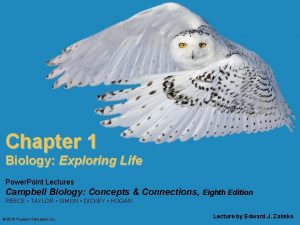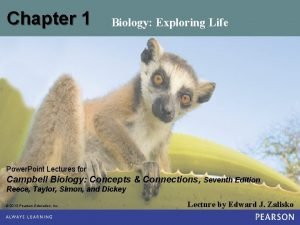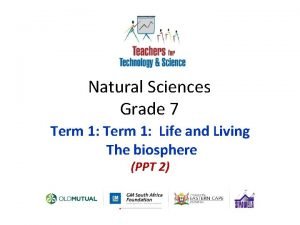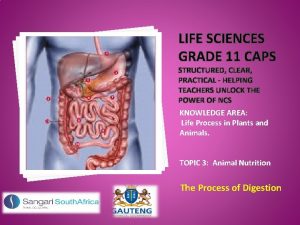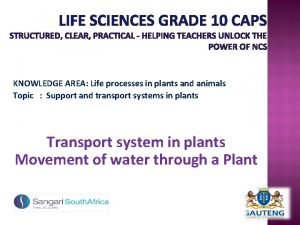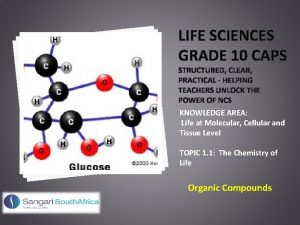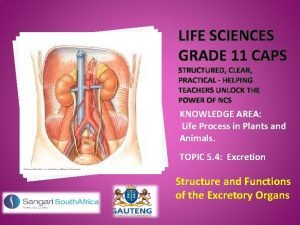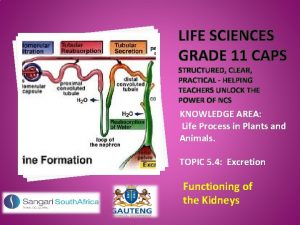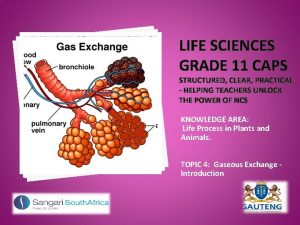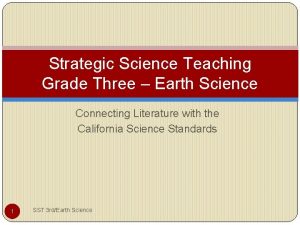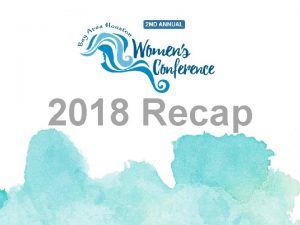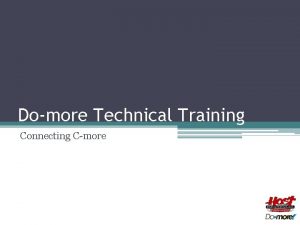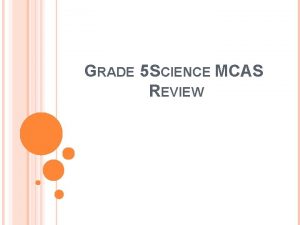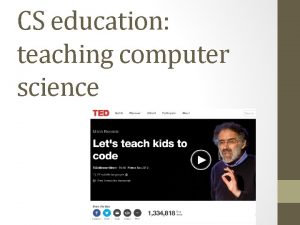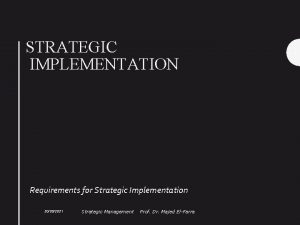Strategic Science Teaching Grade Two Life Science Connecting


















- Slides: 18

Strategic Science Teaching Grade Two – Life Science Connecting Literature with the California Science Standards 1 SST 2 nd/Life Science

A model lesson for each grade level: • Literature selection • Science Standards • Literacy Strategy • Science Investigation 2 SST 2 nd/Life Science

http: //www. cde. ca. gov/ci/sc/ll/ 3 SST 2 nd/Life Science

Browse The Elements Of The Lesson Standards Alignment Lesson at a Glance Teacher Background Materials and Advanced Preparation Teacher Tips Common Misconceptions Explicit script for delivering the lesson through the 5 E instructional model Teacher Reflection Teacher and Student pages 4 SST 2 nd/Life Science

The 5 E Model of Instruction 5 SST 2 nd/Life Science

The Very Hungry Caterpillar by Eric Carle Caterpillar Capers Essential Question: How do the changes that occur in the life cycle of a butterfly compare with the changes in the life cycle of other living things? Student Outcomes: Students learn about the stages in a butterfly’s life cycle and 6 recognize the similarities and differences to the life cycle stages of other living things. Students observe the life cycle of a butterfly and compare this life cycle to those of other living things. Students use “Graphic Outlining” to illustrate information from a. SST fictional story and compare this information to their 2 nd/Life Science observations.

The 5 E Learning Cycle Engage Look at a picture of an adult animal. What do you think the animal looked like when it was born? 7 SST 2 nd/Life Science

Examples of different animals A giraffe looks the same when it is born and when it becomes an adult. A panda bear is very tiny when it is born and grows to become a very large animal. A caterpillar transforms into a butterfly. 8 SST 2 nd/Life Science

Explore – Part 1 Set up the butterfly or moth habitat in an appropriate container for student observation. Ask students to use their hand lens and observe the insect’s egg, then draw and write about what they see. Continue observation time over several weeks as 9 butterfly or moth goes through different stages and have students draw and write to record their information. SST 2 nd/Life Science

Explain –Part 1 At each stage, share student observations with the class and discuss similarities and differences between observations. Label drawings with stage names: egg, larva (caterpillar), pupa (chrysalis or cocoon), adult (butterfly or moth). 10 SST 2 nd/Life Science

Explore – Part 1 Setting up to observe a life cycle • Set up the butterfly or moth habitat in an appropriate 11 container for student observation. • Ask students to use their hand lens to observe the insect’s egg, then draw and write about what they see. (Graphic Outlining) • Continue observation time over several weeks as butterfly or moth goes through different stages and have students draw and write to record their SST 2 nd/Life Science information.

Graphic Outlining (it takes practice!) Graphic Outlining is a method of representing information from a text so that the organizational pattern of the text is highlighted. It helps students understand what they read by leading them to predict and organize information that they encounter. 12 SST 2 nd/Life Science

Explain – Part 1 Tracking changes over time • Assist students with labeling and appropriate names for each stage they observe • Egg • Larva / caterpillar • Pupa / chrysalis / cocoon • Adult / butterfly / moth 13 SST 2 nd/Life Science

Explore – Part 2 Predict what the story is about • Show the cover of The Very Hungry Caterpillar and chart student’s predictions of what the story is about. • Read aloud the book, pointing out changes in the organism as they happen • Was there anything they think was not real in the story? 14 SST 2 nd/Life Science

Evaluate Students research in books and/or on the internet the life cycle of two other living things. Illustrate the stages of each organism’s life cycle and sequence the cycle. Share their drawings. 15 SST 2 nd/Life Science

Elaborate Compare Life Cycles • Ask students to sequence the stages of a frog’s life cycle • Compare these stages with the stages of the butterfly. 16 SST 2 nd/Life Science

Teacher Reflection How does the student work provide evidence that they learned that all organisms have a life cycle with identifiable stages and can explain the four stages in the butterfly’s life cycle. What instructional strategies used in this lesson promote student understanding? How do you know? How does the literature selection support student understanding of the science concepts? How would you modify instruction to ensure 17 understanding of student outcomes by all SST 2 nd/Life Science students?

Strategic Science Teaching Provided by CISC-Science Sub. Committee Your presenter will provide local contact information or you may contact your County Office of Education Science Specialist for more information. Bibliography located in the publication: Strategic Science Teaching Grades K-12: A Sampler of Science Lessons Connecting Literature with California Standards, 2002, CDE 18 SST 2 nd/Life Science http: //www. ccsesa. org/index/sub. Committees. cfm? cid=12
 How to calculate space diagonal
How to calculate space diagonal The shortest arc connecting two endpoints on a circle
The shortest arc connecting two endpoints on a circle Draw two lines one connecting the planet at position a
Draw two lines one connecting the planet at position a Connecting the concepts: exploring life
Connecting the concepts: exploring life Connecting the concepts: exploring life
Connecting the concepts: exploring life Natural science grade 7 biosphere
Natural science grade 7 biosphere Human nutrition grade 11
Human nutrition grade 11 Transpiration practical grade 10
Transpiration practical grade 10 Organic compounds grade 10 life science
Organic compounds grade 10 life science Metabolic waste
Metabolic waste Life science grade 11 kidney practical
Life science grade 11 kidney practical Grade 11 practical gaseous exchange
Grade 11 practical gaseous exchange Strategic fit vs strategic intent
Strategic fit vs strategic intent Puppy dog ploy
Puppy dog ploy Strategic management and strategic competitiveness
Strategic management and strategic competitiveness Strategy analysis and choice largely involves making
Strategy analysis and choice largely involves making Difference between microteaching and traditional teaching
Difference between microteaching and traditional teaching My favourite subject maths for class 4
My favourite subject maths for class 4 Grade 11 annual teaching plan
Grade 11 annual teaching plan
